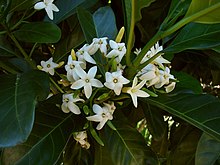Taxonomy
Defined by botanists Rudolf Schlechter and Kurt Krause in 1908, the type species is Atractocarpus bracteatus, which is found only on New Caledonia. [2] Subsequently, several other species were described from New Caledonia.
Meanwhile, the genera Randia and Gardenia had been used as wastebasket taxa, where many species that had been difficult to place had been placed by default. Several Australian species of the genus Randia were found to be not closely related to Neotropical species and were transferred in a review of the genera by Australian botanist Christopher Puttock in 1999; these include several garden plant species such as A. benthamianus , A. chartaceus , and A. fitzalanii . [3]
Puttock also proposed that the genera Sukunia, Trukia, Neofranciella, and Sulitia (the last two consisting of once species each) be sunk into Atractocarpus. The resulting genus now contains around forty species, with seven found in Australia, and others in the Federated States of Micronesia, the Philippines, New Guinea, the Solomon Islands, Vanuatu, New Caledonia, Fiji, Tonga, and east to Tahiti. All species are found in a type of lowland rainforest known as mesophyll vine forests, as well as swamp forests and vine thickets. [4]
This page is based on this
Wikipedia article Text is available under the
CC BY-SA 4.0 license; additional terms may apply.
Images, videos and audio are available under their respective licenses.
